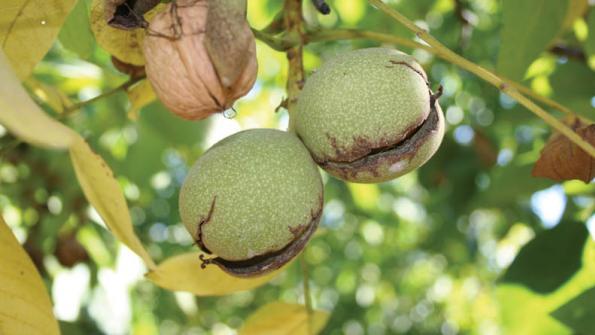
At the start of his walnut harvest on Sept. 10, Sutter County grower Sib Fedora reflected on the 2014 growing season.
“The drought has made for a very interesting year and has kept me very busy,” says Fedora. He and his two sons, Brian and Chris, own and operate Fedora Farms, near Meridian, Calif., where they grow 600 acres of walnuts, plus a mix of field crops.
This year their allocation of Bureau of Reclamation water diverted from the Sacramento River and from the Butte Slough Bypass was reduced by 25 percent. Likewise, deliveries of surface water by his irrigation district, which is supplied by the Bureau of Reclamation, were also cut by 25 percent. In addition, wells help meet some of the trees’ water needs.
Fedora figures that providing water to his sprinkler-irrigated orchards at the right time and in the right amount this season required 20 percent to 25 percent more time and effort than normal.
“It’s taken much more management than I would have guessed,” Fedora says. “But, I think we’ve made it through this year OK.”
He’s done that by making several changes in his farming operation.
One was to alter the usual mix of crops – wheat, lima and blackeye beans and safflower – that that he normally grows on his open ground. He replaced all of his irrigated wheat and bean acreage with safflower, which requires no irrigation. Also, he scrapped plans to plant 80 acres of new ground to walnuts this season.
He used the water saved by these actions to keep his walnut trees healthy and productive.
Fedora also changed his irrigation practices.
“In the past, when we’ve had more than enough surface water, irrigation decisions weren’t so critical,” he says. “This year, everything had to be right on. There was no room for errors. That made it a little more challenging.”
For example, until this year, normally he’d receive water the day after he ordered it. However, in the 2014 season, he had to get in line and wait several days for other growers to get their water. That made timing his irrigations much more difficult.
“We’ve tried to conserve water wherever we could,” Fedora says. “After all, the water available for agriculture has to benefit every grower, not just one or two.”
This year, Fedora began shaking his first trees, the Serr variety, 10 days earlier than last year. After the Serrs, he’ll move on to his Vinas, Tehamas and Howards, before ending the harvest with Chandlers.
Over the years, he’s finished his walnut harvest any time from the first of October to the day before Thanksgiving. He expects to complete his 2014 harvest by mid-November.
“Mother Nature has been really good to us this year,” Fedora says. “We had a pretty good bloom and nut set. Also, we haven’t had an unusually high number of 100-degree or hotter days, and sunburn damage has been minimal up to now.”
Fedora anticipates production of his walnut orchards will be higher this year than last. That’s in line with the USDA National Agricultural Statistics Service’s forecast of a record 545,000-ton California crop. Based on the 2014 Walnut Objective Measurement Survey, released Sept. 5, that would be an 11-percent increase over the 492,000 tons of nuts California’s walnut growers harvested in 2013.
“Across the board, yields of all our varieties look to be above average,” Fedora says. “The nuts appear to be a little bit smaller this year, but there are more of them.”
About the Author(s)
You May Also Like




